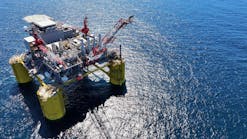Russel Davies
Mobil North Sea Ltd.
Aberdeen
Tim Maltby
Andrew Palmer & Associates
Aberdeen
Mobil North Sea Ltd., Aberdeen, is developing a remotely controlled, mechanical isolation tool for use in servicing emergency shutdown (ESD) valves, such as those required for all pipelines operating in the U.K. North Sea.
The program follows initial use of a freeze plug to isolate the ESD valve on the company's Beryl Alpha platform riser.
SERVICING ESDS
Following the 1988 Piper Alpha disaster and recommendations of the subsequent Cullen report, all offshore pipelines operating in the U.K. North Sea must be fitted with ESD valves that are maintained in good working order.
Although most ESD valves are relatively new, their maintenance is a concern to operators. During any repairs of long trunk-lines, it is desirable to maintain pressure in the pipeline to avoid venting the line.
In high-pressure gas lines, maintaining such pressure poses particular problems.
The 30-in. SAGE (Scottish Area Gas Evacuation) gas trunkline is approximately 325 km (202 miles) long and exports gas from the Beryl Alpha platform to the St. Fergus terminal. The pipeline operates at up to 172.3 bar (2,500 psi) with a minimum operating pressure of approximately 125 bar.
Fig. 1 shows a schematic diagram of the pipeline and the locations of the valves. Relevant to this discussion are the three 30-in. valves on the Beryl riser (two pig-trap isolation valves and one ESD valve) and the three subsea isolation valves (SSIVs) 400 m from the platform.
All valves shown, regardless of size, are welded-in top entry, soft-seated ball valves.
During a 1993 field shutdown, it was necessary to carry out major remedial works on the SAGE pipeline ESD valve as a result of unexpectedly high leakage across the valve during the statutory annual SI 1029 test.
Original plans called for use of the SSIVs to isolate the ESD valve during repairs. Initial testing of the valves, however, made clear that a suitable block and bleed could not be established and that alternative isolation was required.
Mobil North Sea used a freeze plug. The SSIV provided a primary barrier, with the freeze plug providing the secondary barrier. The bleed between the two barriers was achieved with a surface vent from the SSIV.
FREEZE-PLUG ISOLATION
Pipeline pressure for the 1993 repairs was required to be maintained to a minimum of 125 bar during the shutdown (approximately 10 bar above the cricondenbar). Available mechanical tools at that time were limited to a maximum working pressure of 65 bar.
Tests by Marathon and Mobil North Sea had demonstrated that a freeze plug could be used at pressures up to 125 bar. In addition, there was not enough time to procure a pig trap closure with a suitable penetration to allow the use of a tether for the mechanical tools. A freeze plug was therefore chosen for the project,
The plug was positioned in the riser directly below the ESD valve. The SSIV was closed from the platform via a control umbilical, and a diving service vessel was used to control the nitrogen purging and venting of the subsea section of pipeline.
The vessel remained on station throughout the operation; this contributed significantly to the overall cost of the operation (Fig. 2).
After depressurization and nitrogen purging of the riser, a pig train was placed down the riser, with access from the pig trap. The pig train consisted of a slug of glycol between two high-friction pigs (Fig. 3) followed by a slug of gelled water (Fig. 4).
The freeze plug was formed with a freeze jacket and heat exchanger; cooling was supplied by liquid nitrogen. This allowed the temperature of the pipeline to be controlled to a minimum of -50 C.
Thermocouples were placed on the pipeline wall and on the inlet and outlet of the freeze jacket in order to monitor the pipeline temperature and the progress of freezing. The freeze jacket is illustrated in Fig. 5.
A minimum freeze plug temperature of -50 C. was specified because of concerns over defect growth (cracks) occurring in the pipeline with a combination of low temperature and high stress levels.
The pipeline material had originally been specified for a minimum blowdown temperature of -20 C. Additionally, Charpy impact tests were performed to confirm that the fracture toughness of the pipeline steel is acceptable at -50 C.
The stress levels in the pipeline were also reduced by restricting the maximum permissible pressures to 125 bar.
Once the freeze plug was established, after 2-3 days, it was tested in situ by pressurizing the gelled water from the platform side. Previous tests had shown that the freeze plug performed equally well in either direction, and performing the tests in this manner resulted in savings of nitrogen and time.
The topside pipework was then purged of gelled water and made ready for access to the ESD valve. The freeze skid continued to operate throughout the valve maintenance work.
After completion of the valve repairs, the ESD valve was rebuilt and tested via its body cavity in accordance with SI 1029. The plug was then thawed with a preheat blanket, and the pig train removed from the pipeline by pressurizing the riser with nitrogen from the service vessel.
Thawing and removing the plug required approximately 3-4 days. The overall operation of the freeze plug added approximately 8 days to the repair schedule.
EVALUATION
The freeze plug performed satisfactorily for this project in providing an effective isolation at relatively short notice.
Evaluation of the plug's use, however, revealed several disadvantages in its continued use for pipeline intervention:
- The overall cost of the freeze plug was approximately 1.3 million. This cost is entirely consumable and will be incurred each time the freeze plug is deployed.
- Deployment and removal time for the freeze plug is approximately 8 days. This duration could have significant cost implications because of extended downtime.
The operating pressure of the plug is restricted to a maximum pressure of 125 bar because of concern over low-temperature effects on steel properties.
- There are additional safety concerns with the use of a freeze plug. Among these are handling of liquid nitrogen and potential damage to personnel and equipment through spills and the requirement to maintain adequate supplies of liquid nitrogen in order to ensure the integrity of the plug.
- A significant amount of personnel, equipment, liquid storage tanks and nitrogen tanks are required for operation of the plug. These requirements affect transport, storage space, and accommodation requirements for the project.
- Future requirements for the plug may include isolation of horizontal sections of pipe for which the presence of gas in the liquid slug can cause problems.
The gas tends to form a layer of bubbles along the top of the pipeline which reduces the mechanical strength of the plug. In vertical pipelines, this is less a problem because the bubbles form a layer at one end of the plug.
By comparison, a mechanical isolation tool has several advantages:
- The tool can be purchased at an initial capital cost which is less than half of the operational cost of the freeze plug. Additionally, there is a relatively small operational cost of approximately 100,000 for each use of the tool.
The tool can be used as many times as required and can be reused for any further repairs to the Beryl ESD valve.
- The overall deployment and removal time for the tool is approximately 24 hr.
- A tool can be designed to operate up to the design pressure of the pipeline (172.3 bar). This has significant cost advantages for use of the pipeline during repairs.
- The mechanical tool is considered to be more reliable and less hazardous in operation.
- The tool requires fewer personnel, equipment, and liquid-storage tanks for operation.
- The tool can be used equally well horizontally or vertically.
Mobil North Sea's experiences with the freeze plug isolation method have made clear that a more permanent re usable isolation system is required for potential future repair work.
Mobil North Sea has therefore instigated development of a high-pressure isolation tool as part of the emergency pipeline response system.
The company specified four conditions for a suitable tool:
- Operating pressure of 172.3 bar
- Capable of being converted to remote control
- Capable of operating from either end of the pipeline
- Redundancy in operation of the tool.
MECHANICAL ISOLATION TOOLS
Several types of mechanical isolation tool are available. Only one-the expanding collet tool (Fig. 6)-is suitable for high-pressure isolation. The expanding collet tool shown consists of two separate modules connected by a ball joint.
One module contains the locking unit, a set of expanding metal collets which grip the inside of the pipe wall. The lock unit restrains the axial load that results from the pressure difference across the tool. For the 30-in. pipeline, each bar of pressure represents an axial load of approximately 4 metric tons.
The second module contains the seal unit and consists of two sets of elastomeric rings expanded against the inside wall of the pipe.
The polyurethane deforms under pressure and seals the pipe. The annulus between the two sets of seals can be monitored or vented to give a double block and bleed system.
At high pressures, a set of clamps is required on the outside of the pipeline to reduce the hoop stress in the pipe wall. Both the lock unit and the seal unit can cause hoop stresses that exceed the codes' allowances.
The tool in Fig. 6 is controlled by an umbilical which contains multiple hydraulic and electrical cables and a vent from the seal annulus. An umbilical tool is restricted for use within 300-400 m from the point of entry into the pipeline.
Wireline-type tools can be used at distances up to 3 km from the point of entry, while remotely controlled tools can potentially be used along the entire length of a pipeline.
The limitations in length for the umbilical and wireline tools arise primarily because of friction.
Wireline tools have a thin electrical control wire which controls the tool via electrical solenoid valves. Pressure for the hydraulics is provided by pressure accumulators mounted on the tool.
The remote control tool takes this process one stage further (Fig. 7). Control of the tool is performed by a radio link.
The tool has an onboard communications unit which communicates with an external transponder, outside the pipe; the communications are relayed to the control unit. Fig. 8 demonstrates the subsea operation of the tool with the control unit mounted on a diving service vessel.
TOOL OPERATION
Several methods can be used to deploy the tool in the pipeline:
- ushrod: for very short distances along straight sections of pipe.
- Pigging in a liquid slug: within relatively close proximity to the pig traps (especially offshore). The main limitation to this method is the quantity of liquid required for the liquid slug.
- Pigging in gas: potentially for use along the entire length of the pipeline with either live product gas or nitrogen.
The pushrod method is demonstrated in Fig. 9. For repairs to the ESD valve, a pushrod would be unsuitable because of difficulties deploying the tool around the bend.
Fig. 10 illustrates pigging the tool in a gas or liquid slug. Use of gas to pig the tool is difficult because of stick-slip friction behavior.
The tool will tend to stop and start in an uncontrollable manner, particularly as it enters the riser section. This makes positioning of the tool very difficult and can potentially cause damage to the tool and the valves.
Pigging the tool in a liquid slug is the preferred method of deployment because it allows accurate control and positioning of the tool and minimizes possible damage to the tool and valves.
The geometry of the riser and of the ESD valve requires that the tool be positioned to within 100 mm. The position of the tool can be determined with magnetic or radioactive detection systems.
Once in position, the tool is set hydraulically. The tool is designed so that a differential pressure of approximately 10-15 bar across the tool self-energizes the locking and sealing modules.
Thus once the tool has been properly set, increasing pressure grips the tool more tightly into the pipe wall. Similarly, the tool can be un-set either hydraulically or by reversing the pressure across the tool. The tool can then be pigged back to the entry point.
Once set in position, the tool will be leak tested in situ. This will be achieved by pressurizing the section of pipeline below the tool to 110% of the operating pressure of the pipeline.
The liquid slug will then be drained before the ESD valve bonnet is opened for repairs.
Removal of the ball from the valve requires that the tool umbilical be split. This is achieved by specially designed disconnection couplings on the umbilical. The ball is removed halfway out of the valve, the umbilical disconnected, the ball completely removed, and the umbilical reconnected.
The process is reversed during reassembly of the valve. Venting of the seal cavity or control of the tool hydraulics cannot be performed while the umbilical is disconnected, a period of approximately 6-12 hr.
Fig. 11 shows the positioning of the tool. It is approximately 2.5 m in length and will be located below the ESD valve and above the proposed vent line.
A vent line in the riser was installed this summer to provide a means of venting the section of riser between the ESD valve and the SSIV.
A double block and bleed would then be achieved by using the SSIV and the tool as double blocks and bleeding through the vent.
REMOTE CONTROL SYSTEMS
Possible future repair work may require a remotely controlled isolation tool to be used, and it is anticipated that the umbilical tool will be converted to remote control for this purpose.
A remote-control system will allow the tool to operate subsea and at long distances from the pig traps. The operating range of the umbilical tool is approximately 400-500 m from the pigtraps.
Conversion of the tool will consist of several components:
- Communications hardware: The radio system which is used to transmit information to and from the tool.
It consists of an onboard communications and micro-processor control unit on the tool, an external communications unit which is located outside the pipeline, and a control console which may be situated beside the riser or onboard a DSV.
For subsea use, a subsea to surface link is also required.
Typically, the remote control system will be duplicated, with a number of channels to control the valves, to monitor pressure, and to provide an alarm system.
- Communications software: The means to control the communications system, including protocols and encoding to prevent accidental operation of the tool. It is, for example, undesirable that any random electrical signals may cause the tool to unset.
- Tool hardware: Electrical solenoid valves, pressure accumulators, and batteries.
- Tool transport and positioning system: Modifications to the tool to enable it to travel long distances and a braking and positioning system so that the tool can be pigged into position in the gas flow.
Several different remote-control systems will be available for future conversion of the tool. No definite choice has been made at this stage as to the most suitable System, partly because all of the systems are currently under development.
It is pertinent, however, to make some observations about the selection of a suitable system.
Close cooperation between the supplier of the tool and the remote-control system supplier is essential. The performance of the tool depends upon the interaction of the various components described above.
This can only be achieved if there is a full interchange of information between the suppliers, or ideally if the remote-control system is supplied in-house.
Furthermore, the expense of developing a suitable system will tend to favor the companies with higher turnover.
Additionally, development of the mid-line capability (long-distance travel) and of the gas-pigging capability (braking and positioning systems) are important parts of the remote-control system.
These capabilities will provide maximum flexibility and allow the tool to be used along the entire length of the pipeline.
And finally, the costs of remote control tools are likely to decline over the next few years as development costs are absorbed.
Copyright v92i41.html Oil & Gas Journal. All Rights Reserved.


